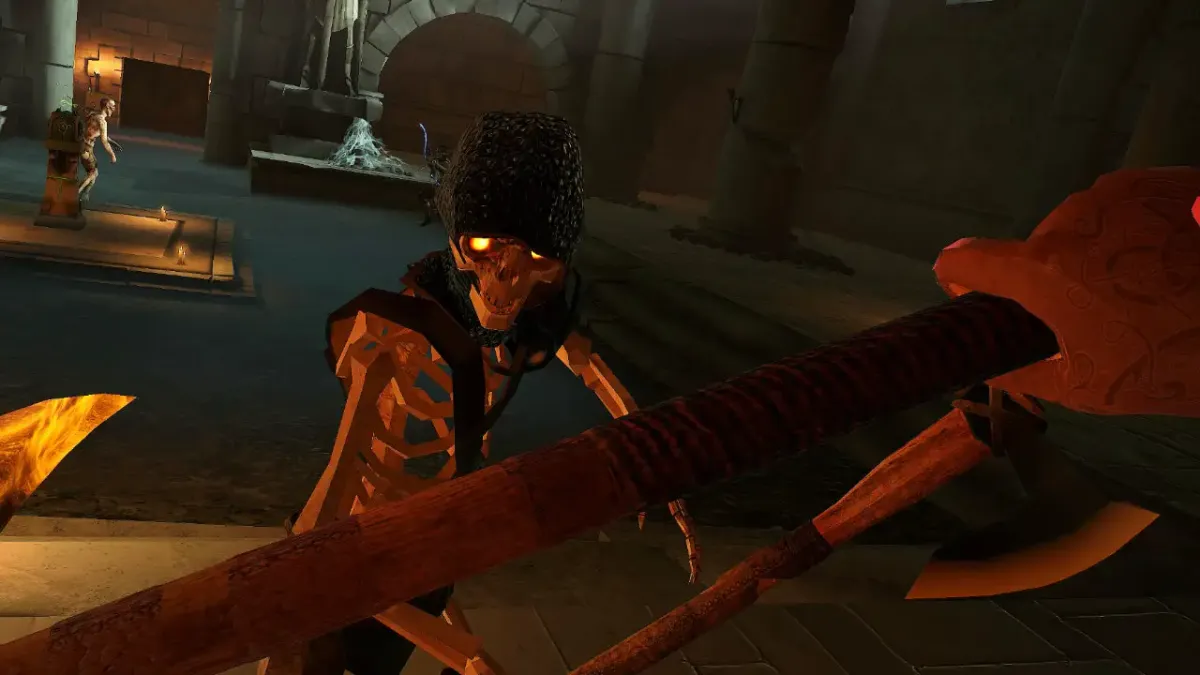
Almost without exception, virtual reality is a solo experience. Even games that do support multiplayer are often competitive or just a leaderboard. One area that is consistently underserved is cooperative play, virtual reality or not. What looks like a simple dungeon crawler, reveals itself to be a physics-based monster slayer bent on crushing the players until they ultimately prevail. Misery loves company – bring a friend, armor up, and let’s explore the Dungeons of Eternity.
So the story goes, your planet of Eternity has suffered some sort of catastrophic world-ending cosmic event. You and up to two additional friends, will delve into the hearts of the randomized dungeons to plumb their depths for a mysterious object said to be the planet’s only hope for survival. Time to throw on your Meta Quest 2 or 3 (it’s exclusive, at least for now) and venture forth.
Developer Othergate is a newcomer, with Dungeons of Eternity being their first game, but don’t think they are new to the VR space. The small team of a half-dozen developers have over 30 years of combined experience in the virtual reality development realm, and firing up the game for the first time, it really shows.
Dungeons of Eternity is a physics-based dungeon crawler, to be sure, but it’s also taking a lot of cues from other games in adjacent genres. The randomly generated dungeons are a welcome sight, as are the trap rooms, monster arenas, secret areas, and more. It quickly scratches a first-person Dungeons & Dragons itch that I’m sure I’m not alone in having. Throw in an RNG-based loot system with swords, bows, maces, magical staves, shields, and more and any D&D nerd will feel right at home.
Entirely too many VR games have that same list of weapons, but that doesn’t a good game make. What makes Dungeons of Eternity work is that all of these weapons are brought to life in a way that makes them feel actual implements of combat. Swords clang off of each other realistically. An axe can also parry against its blade or handle, and can (and often will) hook another weapon (including your own if you swing it wildly), allowing for a disarm. Bows have a heft to their pull, landing with a satisfying thud. A great deal of care was put into combat, and it shows.
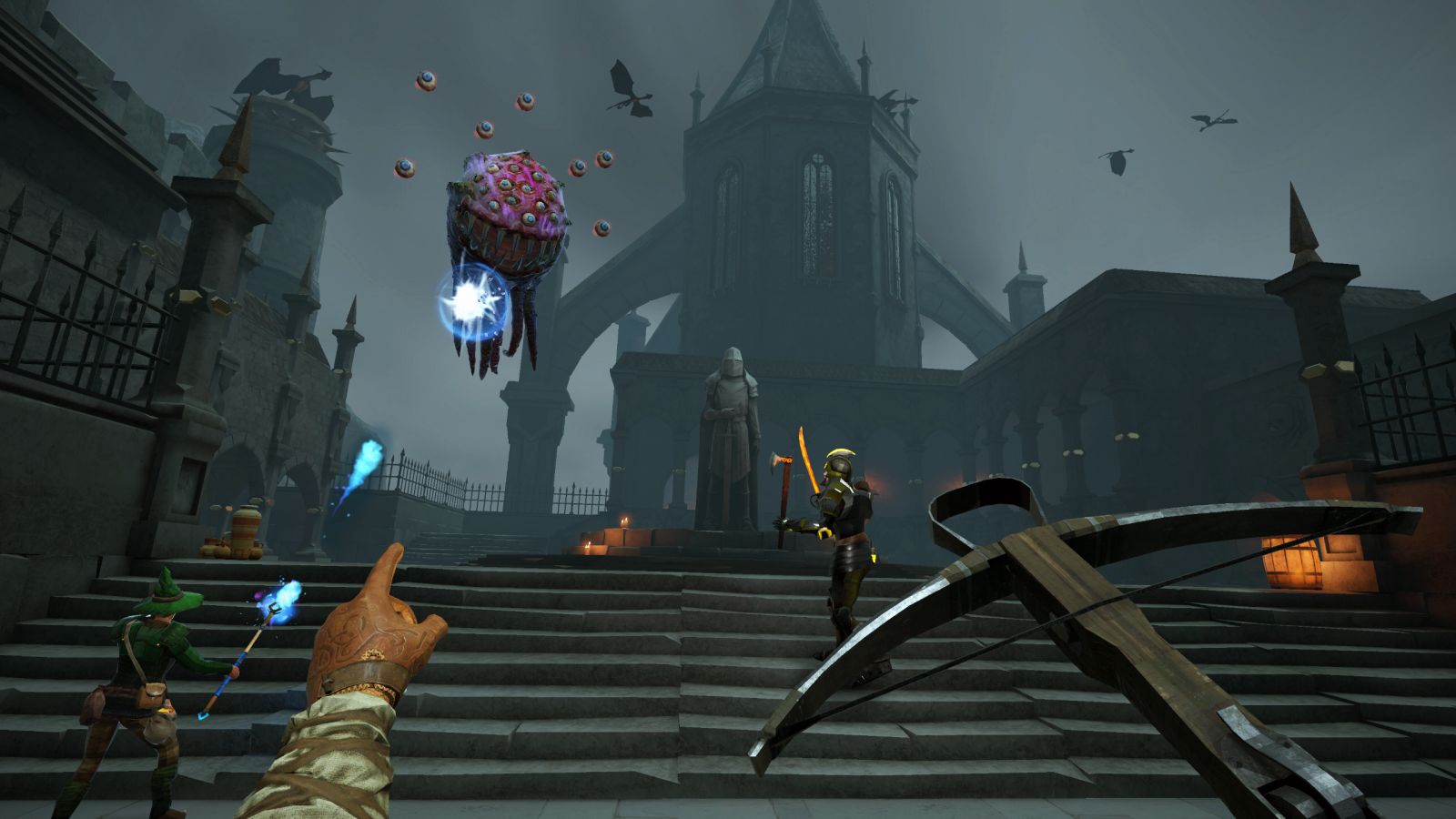
If you are expecting Dungeons of Eternity to unfold after the adventurers gather up at the local tavern, that’s understandable but also inaccurate. In point of fact, the game unfolds on a space station. While you might be collecting swords and magical staves, you then store them in a room filled with holographic representations of these things. Each of the dungeons are accessed via a table that would look as welcome on a Warhammer 40K Strike Cruiser as it does here. Let me pontificate for a moment.
To be clear, all of the dungeons we’ve seen thus far have been of the skeletons and armored ogre variety, there’s nothing to stop Othergate from changing things up. Technologically advanced dungeons are possible. Derelict warehouses, crashed ships, and monster-filled modern dungeons are equally possible. There’s nothing stopping the development team from using the sci-fi mission table from allowing the player to truly embark on the potential of infinite dungeons with limitless possibilities. Perhaps that’s in the future? For now, let’s bash skeleton heads.

One of the biggest ways VR makes you feel powerful is with its interactive elements. Swinging your sword into a skeleton won’t do a ton of damage, but blasting them with magic, a mace, or an axe might do the trick. More than once I’ve gotten my axe stuck inside the head of a skeleton that I then used as an impromptu mace against the next shambling bonebag. Clearing that skull off of your axe with your other weapon (you can dual wield any time you’d like) is one of those small interactive elements that makes Dungeons of Eternity work.
I should mention that the game is rather punishing. Monsters will overwhelm you if you aren’t carefully planning your actions. Monsters can and will flank you, and there are plenty of big scary boss monsters that can appear at a moment’s notice. Dodging, blocking, and parrying will win you the day, most of the time, but a little level up work might be in order.
I was surprised at how well I fared at the natural motion option in Dungeons of Eternity. There are a number of teleport, vignetting, snap turns, and other motion sickness abatement options in the game, but I just didn’t need them. I was able to play several hours without a single nausea wave. Your mileage may vary, but given how sensitive I am to it, it’s great to report that this was a nausea-free game for me.
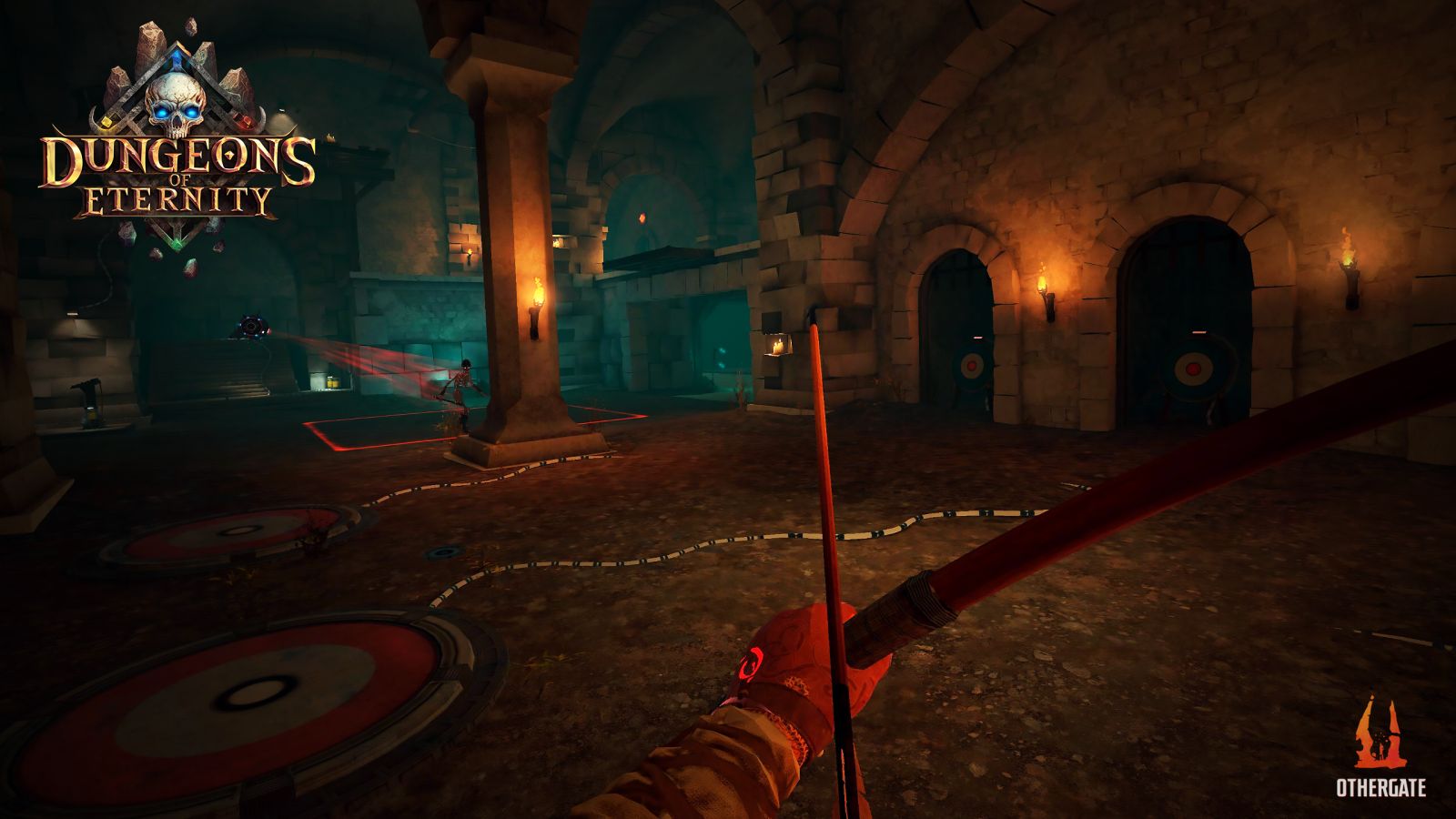
Unlike many VR games, Dungeons of Eternity has a progression system. You’ll find gold throughout the various levels, as well as cosmetics like the ability to make your avatar bald, adding elf ears, a mohawk, sleeveless jerkins, and much more. These are often hidden in offshoot rooms, or locked in a box with keys. Taking the time (and battling the inevitable monsters) to seek them out is your key to building out your toon.
As you play, you’ll find several weapon types. You start with a sword and an axe, as well as a bow on your back, but opening the aforementioned boxes will yield new gear. Mage staves are eventually on the menu, and magical weapons await your discovery. These aren’t revealed as you find them, instead shown as loot at the end of your dungeon. This game is very much an ARPG, so you’ll find equipment with a slight boost to your various stats. Keep grinding and you’ll unlock staves that fire lightning, bows that set monsters on fire, and more. The real skill isn’t in gear, though.
The thing about VR is that technically you are the equipment, and nowhere is that more true than in Dungeons of Eternity. Swinging your axe or hammer is fine, but swinging it harder does more damage. I don’t know how much more, but I can certainly tell the difference between a heavy swing and a light one. Better still, throwing your weapons and then recalling them had me feeling like discount Thor. After just an hour I felt the allure – this is essentially VR Gauntlet, and I’m absolutely here for it.
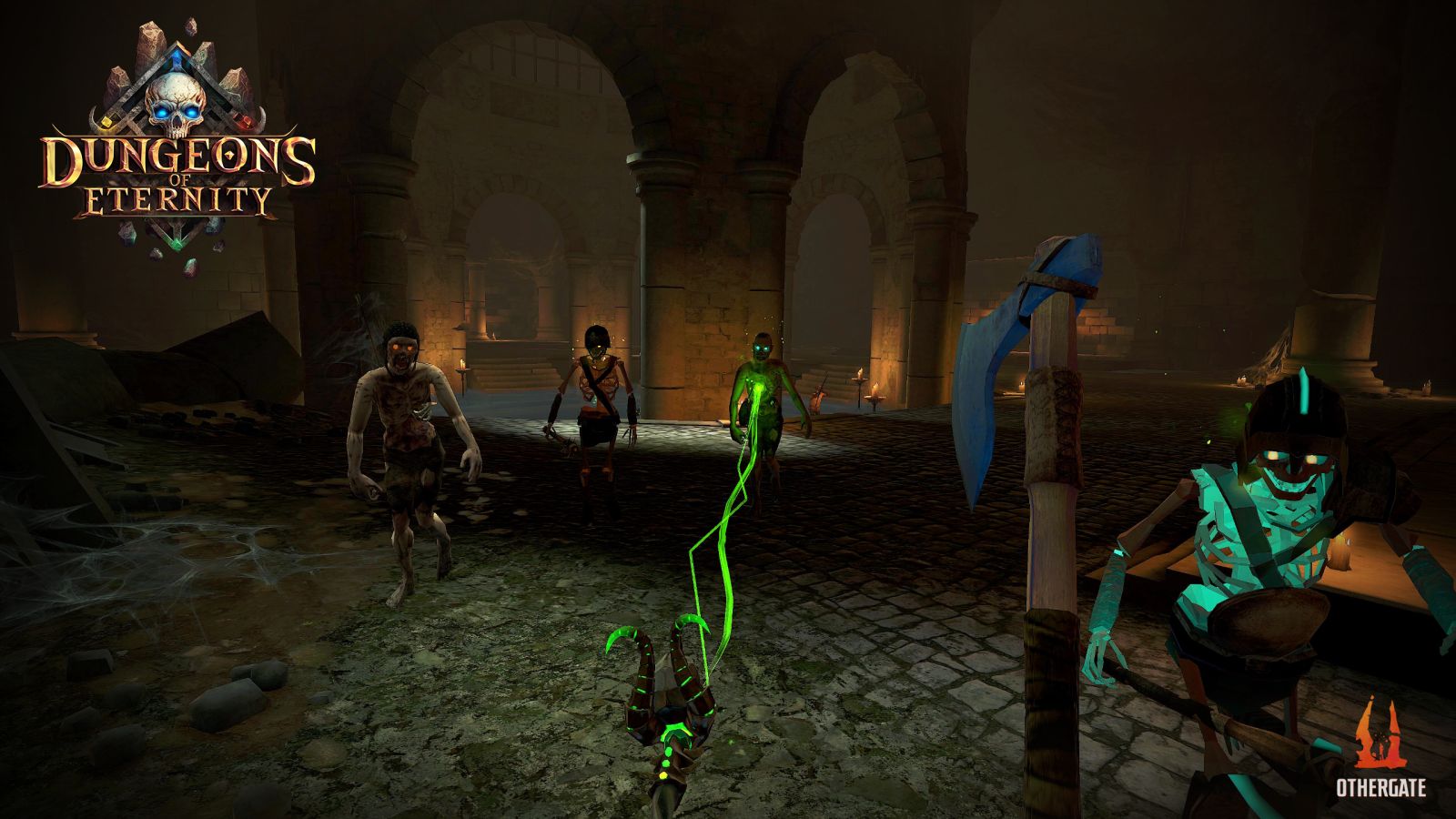
Talking with Othergate co-founder Ryan Rutherford, he and the team wanted to make something that felt a little like classic Legend of Zelda in first person, and by all accounts, they’ve succeeded. While the room layout is randomized, as are the monsters and loot, they are laid out across 12 dungeons with four themes and three modes. The modes are Dungeon Raid, Soul Harvest, and Crystal Hunt.
Dungeon Raid blends the semi-medieval theme with a dash of technology. In the dungeon lies a crashed drone, and the monsters have the batteries to re-power it. Smash the monsters, grab the batteries, and then teleport out – simple. Soul Harvest is a semi-horde mode. You’ll visit a wraith type creature that reminds me very much of Vulgrim from the Darksiders series, and he’ll provide a soul staff that needs filling. Zapping a monster with the staff “tags” them so they can be cut down and their soul removed. Collect them all and return them to the wraith and he’ll kick off another round. Three increasingly difficult rounds later and you’ll succeed, collecting a ton of loot, coin, and more. Some optional rooms also open up, fraught with their own dangers, but rewards in equal measure – tread lightly. The last mode is Crystal Hunt. In Crystal Hunt you’ll enter a massive pyramid. In the center are three crystal slots. Heading into the wings of the pyramid you’ll find those crystals, guarded by monsters, naturally. With the crystals retrieved and placed, you’ll then power them up by standing in a node. This also powers up your weapons, and you’ll be glad it did – the monsters that come for you are heavy hitters.
I played Dungeons of Eternity on the Meta Quest 2 and the Meta Quest 3. The new headset gets a few new tricks with a fresh dash of lighting and bloom effects, but it looks good on both headsets. Particle effects are liberally applied as you strike monsters with magical spells. The lighting is fantastic as you hold a torch aloft to light the way. The randomized monsters start off fairly generic – skeletons, bats, zombies, and the like, but soon you’ll face giant spiders, wasp bosses, armored barbarian types, and more. Don’t be fooled by the first few outings – there’s more to discover.
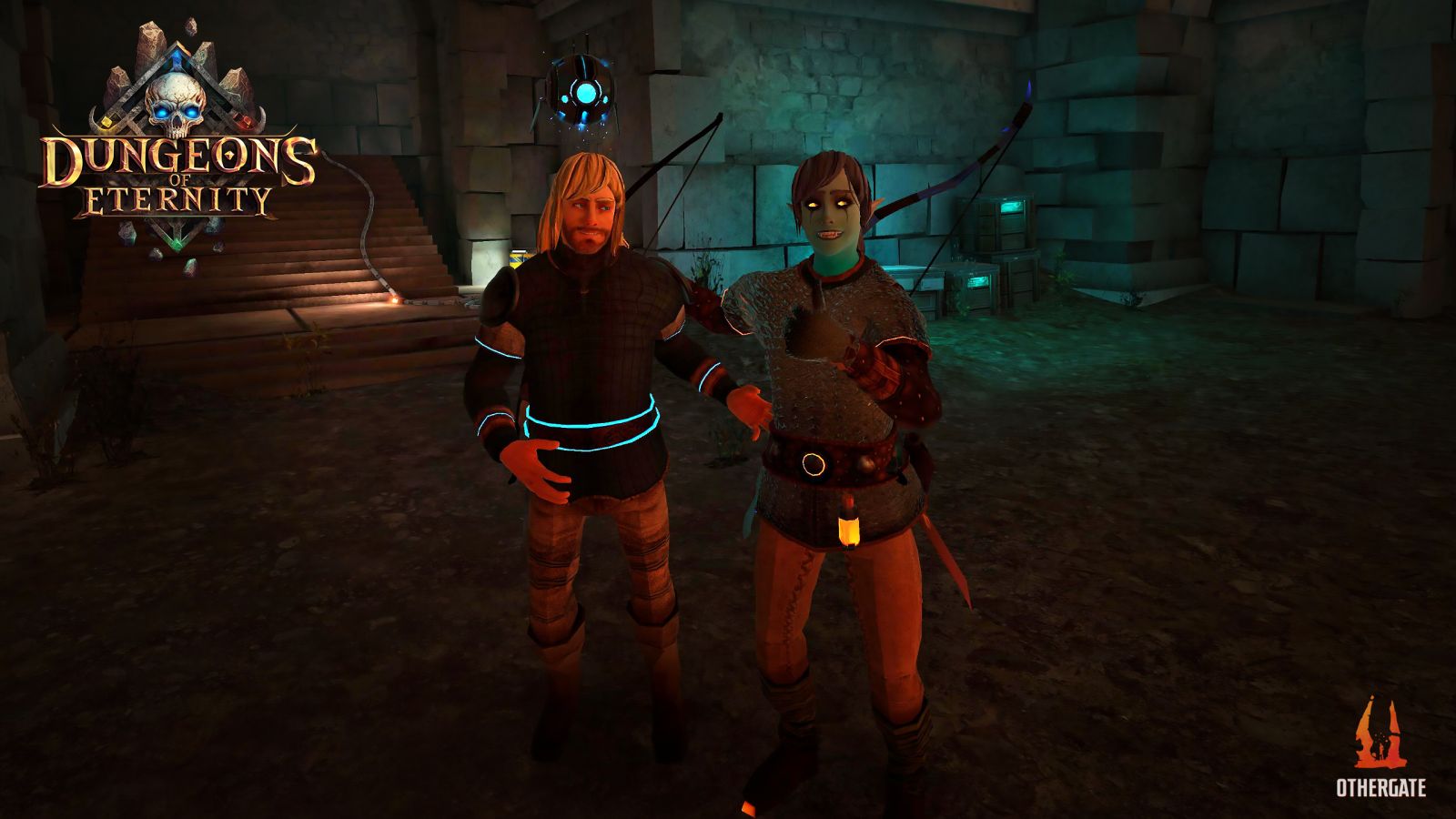
I have to commend the Othergate team for their work in the audio department. The ring of steel as you clash weapons (including your own) has a solid impact to it. Cracking skulls with a hammer has a thump and crunch to it, and the thwip of the bow feels right. It’s important, too, as monsters have no problem spawning behind you and giving you a death hug before you see them coming.
Once you’ve plumbed the depths of a few dungeons, you’ll level up. Heading back to your room (everyone has their own space where they can customize their character, fabricate new weapons and potions, and spend points on their “Exosuit”. The Exosuit is just a fancy way of allowing the player to add points to their various stats. Again, however, the real skill is in your own hands, so these effects are decidedly minimal.
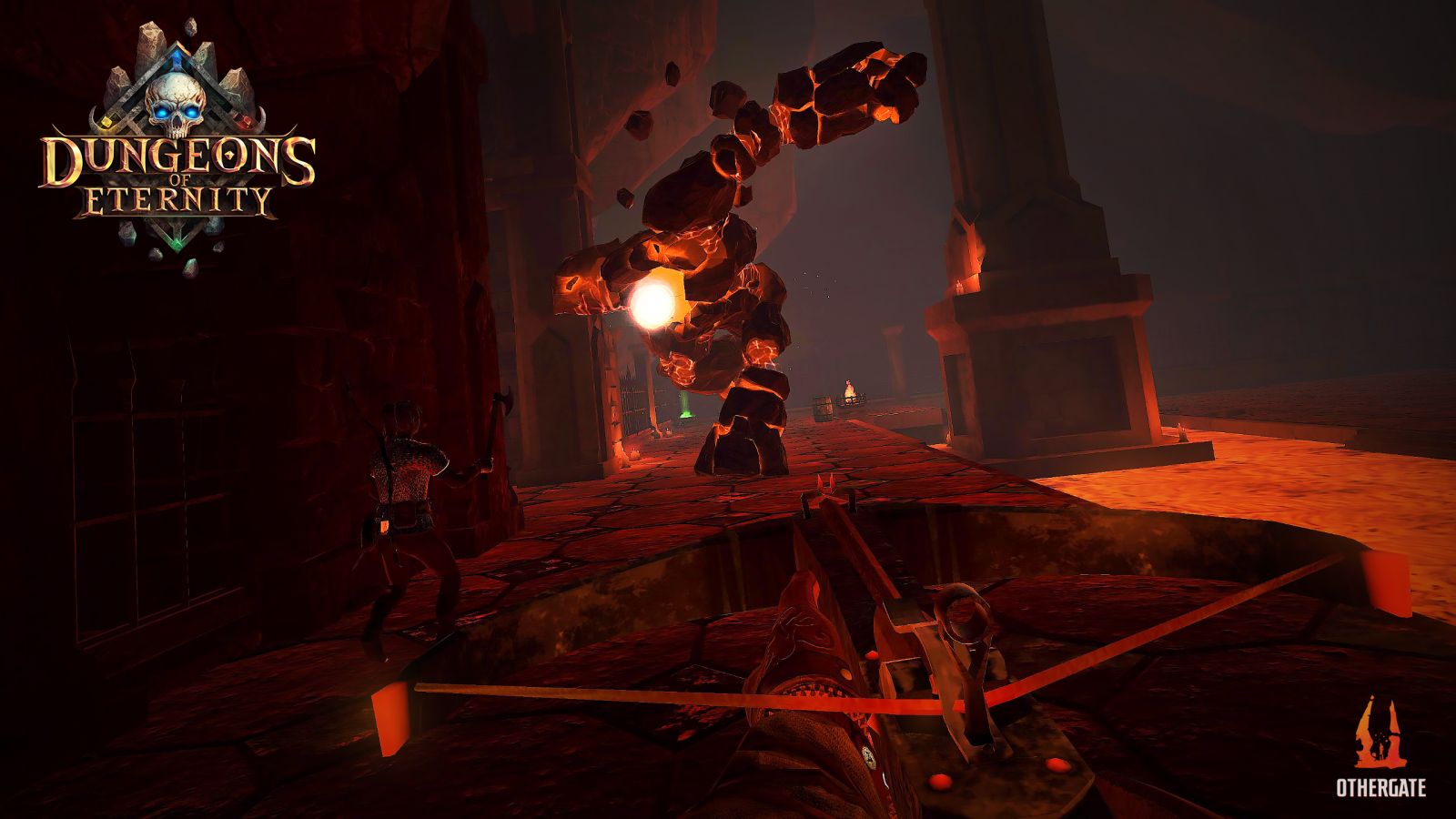
If you are looking for the section in this review where I talk about the central narrative, well…there isn’t one. You can piece together the little bit about the catastrophic end of the world stuff, but the dungeons aren’t tied together in anything but theme that I was able to find. The narrative is “See that monster thing running towards you? Kill it.” That’s enough when playing with friends, but it just doesn’t pass muster when playing by yourself.
Ultimately you can play Dungeons of Eternity alone, but the real fun begins when another player joins you. Working as a team, sharing potions, equipping complimentary weapons, and tackling dungeons as a team is a huge multiplier to the fun. In that, Dungeons of Eternity stands almost alone on the Meta platform. Best of all, talking with the developers they’ve made it clear that they are just getting started. Balance, new modes and worlds, and fresh content lies just over the horizon. While the game is currently exclusive to the Meta ecosystem, here’s to hoping it can also come to PCVR and PSVR2 – dungeon crawling is always better with friends.
Dungeons of Eternity
Great
With up to three friends, the randomized dungeons, progression, and physics-based combat creates a compelling and fun virtual dungeon delving time.
Pros
- Physics-based combat is a blast
- 12 Randomized dungeons keep things fresh for a bit
- Play-your-way character progression system
- Nausea-free experience
- ARPG-like weapon progression
Cons
- Could use a bit more content
- Story is paper thin
- Variety will run out soon
